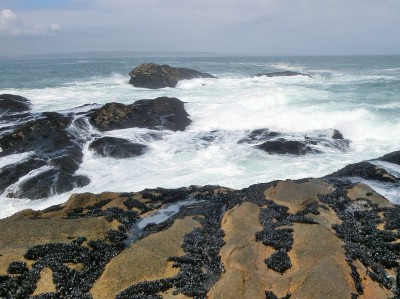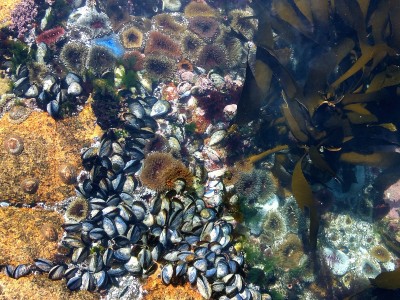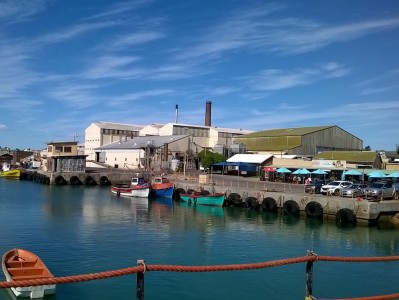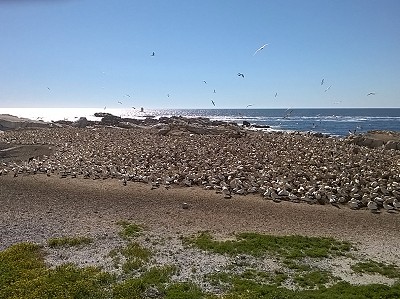 The seaside is changing along the southern Atlantic coast of South Africa between Saldanha Bay and Lambert's Bay, places that are situated a short northward drive from Cape Town. Tourism replaces fishery. Both economic activities are depending on a healthy coastal sea and sustainable use of this coastal resource system.
The seaside is changing along the southern Atlantic coast of South Africa between Saldanha Bay and Lambert's Bay, places that are situated a short northward drive from Cape Town. Tourism replaces fishery. Both economic activities are depending on a healthy coastal sea and sustainable use of this coastal resource system.
The coast does not offer much shelter. The coastal landscape is rocky, such as at Cape Columbine, interspaced with open sandy bays. The swell is rolling onshore, battering the granite of low-laying cliffs and breaking at the feet of dune lines. The local coastal aquifer nowadays holds brackish water as a results of over-abstraction to irrigate ever thirsty fields. It’s been and continues to be a difficult place to live, at least so far.
Along the west coast of South Africa flows the Benguela Current. Its northward water flow sustains coastal upwelling of cold nutrient rich water. Subsequently, kelp, fish, shellfish, birds and seals are emblematic species in a rich marine ecosystem.
 The land is arid, attractively flowering in spring after winter rains. The scarce rains and some fog do not sustain much rain-fed agriculture. It's recent expansion depends on ground water for irrigation. Only some permanent rivers (e.g. Berg River, Olifants River) cut from the mountains through the plains of Pleistocene sea bottom.
The land is arid, attractively flowering in spring after winter rains. The scarce rains and some fog do not sustain much rain-fed agriculture. It's recent expansion depends on ground water for irrigation. Only some permanent rivers (e.g. Berg River, Olifants River) cut from the mountains through the plains of Pleistocene sea bottom.
In former times, the local African people (Sam and Koih) could harvest some seafood from the tidal pools. However the coastal islands with substantial seal and bird populations were out of reach of these hunter-gatherers or pastoral cultures.
That situation changed when Portuguese and other European seafarers arrived about 400 years ago. Initially, they collected eggs, meat, oil, and seal skins from the islands, later guano. Transport was by boat along the dangerous coast. It was a difficult business. However, it wasn't until the early twentieth century that more modern entrepreneurs overexploited local resources drove significant changes in ecosystem e.g. through gathering of millions of penguin eggs.
 In the late nineteenth century dirt roads started to connect the coast to the interior plains at the feet of the mountain ranges, where more people lived and agriculture prospered. This proved a strong incentive to developing a fishery business for local markets.
In the late nineteenth century dirt roads started to connect the coast to the interior plains at the feet of the mountain ranges, where more people lived and agriculture prospered. This proved a strong incentive to developing a fishery business for local markets.
Preservation and transport of produce still relied on local means. In the early twentieth century the use cars and trucks created an even bigger pull to develop the coastal fishery business further.
The fishery businesses were located in villages such as Paternoster or Lambert’s Bay and sustained local communities for some decades, up to the 1990s. The processing of seafood apparently was done both, in an artisanal or industrial manner, in Paternoster and Lambert’s Bay, respectively.
About two decades ago, the fishery came to its end as a local industry. Possibly, the economic opening of South Africa after the end of the apartheid undermined the profitability of the local businesses.
 On the other side, paving of the dirt roads to the coastal villages in the early 2000s provided these villages with a much easier connection with the entire country, in particular to the Cape Town area. Nowadays, these formerly remote places can be reached from Cape Town within a two or three hours drive.
On the other side, paving of the dirt roads to the coastal villages in the early 2000s provided these villages with a much easier connection with the entire country, in particular to the Cape Town area. Nowadays, these formerly remote places can be reached from Cape Town within a two or three hours drive.
Subsequently sea-side tourism took off with fresh seafood among the attractions. Zoning of residential areas with holiday-homes to rent for summer vacation changed the economic development for Paternoster and Lambert’s Bay in the last decade.
Some scattered remains of the local fishing industry or dwellings of fishermen are surrounded by vast residential areas of 'summer cottages'. And as locals tell, more diversified jobs in building and servicing business are available, including weekly beach-combing for plastic and other cultural debris that the sea is washing ashore.
Impressions by Dr. Martin Bohle (photos by the author).








